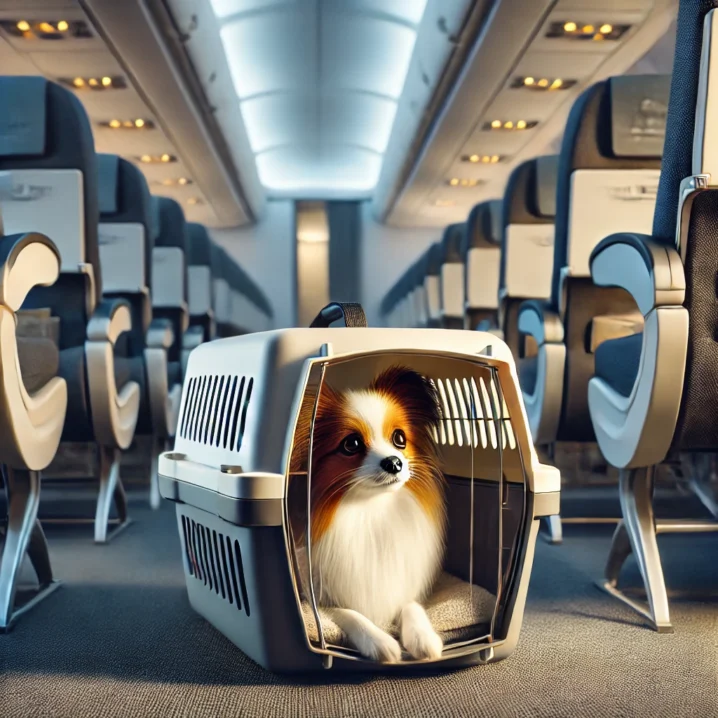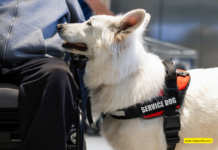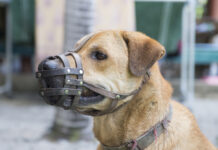Last Updated on October 24, 2024 by Dogs Vets
Flying with your Dog?
Are you planning on flying with your dog? With various airline pet policies, it’s essential to be prepared to ensure a comfortable and stress-free flight for both you and your furry companion. In this comprehensive guide, we’ll walk you through the key considerations, health checklists, and airline-specific rules to guarantee a seamless travel experience.
2. Should Your Dog Fly?
Before making a decision, consider the potential stress and health implications of air travel on your dog. According to Dr. Jerry Klein, Chief Veterinary Officer for the American Kennel Club, “Traveling by air can be stressful to people and to dogs” (1). Factors to consider:
- Age and health: Puppies, senior dogs, and dogs with pre-existing medical conditions may not be suitable for air travel.
- Size and breed: Large breeds or dogs with respiratory issues (e.g., Pugs, Bulldogs) may face additional challenges.
- Temperament: Anxious or aggressive dogs may not adapt well to the flying environment.
Consult with your veterinarian to determine if flying is suitable for your dog.
3. Preparing to Fly
3.1 Research and Confirmation
- Verify pet policies: Check with your airline for their pet policy, including any restrictions or requirements.
- Destination regulations: Research the destination’s laws and regulations regarding traveling with dogs.
- Quarantine and vaccine requirements: Ensure you comply with all necessary measures to avoid delays or issues upon arrival.
3.2 Health Checklist
- Schedule a veterinary appointment: Confirm your dog’s health and obtain an updated rabies certificate.
- Pack necessary medications: Include preventative flea and tick treatments, and a specialized diet (if applicable).
- Obtain a health certificate: Required for some airlines and international travel (within 10 days of travel).
3.3 Essential Items to Pack
- Proof of vaccinations
- Airline-approved carrier
- Portable water and food bowls
- Treats, poop bags, and pet wipes
- Comfort items (e.g., favorite toy, blanket)

4. Airline-by-Airline Guide
Please note that airline policies are subject to change. Always confirm with your airline before booking.
| Airline | In-Cabin Pets | Cargo Pets | Fee |
|---|---|---|---|
| Alaska Airlines | Allowed (small dogs) | Allowed | $100 |
| American Airlines | Allowed (up to 11.5 hours) | Restricted (US Military/State Department only) | $150 (in-cabin), varies (cargo) |
| Delta | Allowed (ventilated carrier) | Allowed (IATA-compliant carrier) | $95 (domestic), $200 (international) |
| Frontier | Allowed (small dogs, domestic flights) | Not Allowed | $99 (each way) |
| Hawaiian Airlines | Allowed (interisland and mainland US flights) | Allowed (weight restrictions apply) | $35 (interisland), $125 (mainland US) |
| JetBlue | Allowed (small dogs, under 20 pounds) | Not Allowed | $125 (each flight) |
| Southwest Airlines | Allowed (domestic flights, six pets per flight) | Not Allowed | $125 (pet carrier, US Mainland flights) |
| Spirit | Allowed (small dogs, domestic flights) | Not Allowed | $125 (pet fee, each flight) |
| United | Allowed (domestic and international flights) | Not Allowed | $125 (each flight, additional fees for layovers) |
5. Frequently Asked Questions (Q&A)
- Q: Can I purchase an airline seat for my dog?
A: No, dogs cannot occupy a paid seat. They must fly in an approved carrier under the seat in front of you or in cargo. - Q: Are emotional support animals considered pets?
A: Yes, as of 2021, emotional support animals are classified as pets and must follow the same guidelines. - Q: How can I prepare my dog for flying?
A: Familiarize your dog with their crate, expose them to loud noises, and consider training for the Canine Good Citizen (CGC) title. - Q: Can I take my dog out of the carrier during the flight?
A: No, dogs must remain in their carriers during the flight. However, you can give them a chew to comfort them during turbulent periods. - Q: Are there specific health requirements for dogs flying internationally?
A: Yes, check with your airline and the destination country’s regulations for required vaccinations, health certificates, and microchipping.
6. Preparing Your Dog for Flying
6.1 Crate Familiarization
- Introduce the crate gradually, starting with short periods.
- Make the crate a comfortable space with familiar bedding and toys.
- Encourage your dog to enter the crate willingly.
6.2 Noise Desensitization
- Expose your dog to various noises (e.g., airplane sounds, loud music).
- Reward calm behavior.
- Gradually increase noise levels to simulate the flying environment.
6.3 Canine Good Citizen (CGC) Training
- Enroll in a CGC training program to help your dog become more confident in new environments.
- Focus on basic obedience and socialization.
7. Airport and In-Flight Experience
7.1 Checking In and Security
- Arrive early to account for any potential issues.
- Inform the check-in staff about your dog and provide required documentation.
- Be prepared for security screening:
- Small dogs in carriers: screening with you
- Large dogs or cargo: separate screening process
7.2 Airport Pet Relief Areas
- Locate designated pet relief areas for your dog to stretch and relieve themselves.
- Keep your dog on a leash (unless in a designated off-leash area) and clean up after them.
7.3 In-Flight Etiquette
- Keep your dog calm and quiet during the flight.
- Follow flight attendant instructions regarding your dog.
- Be respectful of fellow passengers and keep your dog’s carrier securely stowed.
8. International Travel with Dogs
8.1 Additional Requirements
- Import/Export Permits: Obtain necessary permits for your destination country.
- Vaccinations and Medications: Ensure your dog meets all vaccination and medication requirements.
- Microchipping: Microchip your dog with an ISO-compliant microchip (15-digit).
8.2 Country-Specific Regulations
- Research Destination Regulations:
- EU: Check with the European Food Safety Authority (EFSA) for regulations.
- Australia: Consult with the Australian Department of Agriculture, Water and the Environment.
- Other countries: Research specific regulations for your destination.
Country-Specific Examples:
- United Kingdom: Tapeworm treatment required within 1-5 days of arrival.
- Australia: Quarantine periods apply for some breeds and countries of origin.
- Japan: Import permits and specific vaccinations required.
9. Conclusion
Flying with your dog requires careful planning, research, and preparation. By following this comprehensive guide, you’ll be well-equipped to handle the challenges of air travel with your furry companion. Remember to always prioritize your dog’s safety, comfort, and well-being.
References:
- American Kennel Club (AKC): “Traveling with Your Dog”
- Centers for Disease Control and Prevention (CDC): “Importation of Dogs and Cats into the United States”
- International Air Transport Association (IATA): “Traveler’s Pet Corner”
Additional Resources:
- US Department of Agriculture (USDA): “Traveling with Your Pet”
- Pet Travel: “Airline Pet Policies” (comprehensive database of airline pet policies)
- World Animal Protection: “Traveling with Pets” (global resources and advice)
Note: The links provided are subject to change, and it’s always a good idea to verify the information with the respective organizations for the most up-to-date guidance.

















